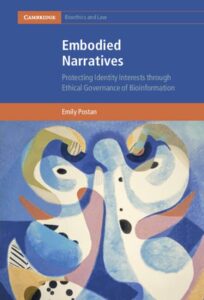Dr Emily Postan, Deputy Director of the Mason Institute
Does it matter that you know who your genetic parents are, who you are related to, and how the story of your life began? Does it matter for your emotional wellbeing, or your feelings of connectedness and belonging? Is it significant to your identity and sense of who you are?
These questions sit at the heart of long-running debates about which information should be available to people conceived using donated gametes (sperm or eggs) about their conception and their gamete donors. Significant changes in our online behaviours and the seemingly unstoppable popularity of online ‘direct-to-consumer’ genome testing services like 23andMe and AncestryDNA have opened up new routes to accessing information about donor origins. Here I argue that people’s interests in constructing and making sense of their own identities must play a central role in any changes to the law that seek to respond to these developments.
Regulatory priorities are a’changing
When it comes to information access in the UK, milestones and new challenges are afoot. Next year, young people who were conceived using gametes donated after the 2005 change in the law to remove gamete donor anonymity will reach adulthood. This means they will finally be apply to find out who their gamete donors were (provided their parents were treated in a licenced UK fertility clinic). Meanwhile, the UK regulator, the Human Fertilisation and Embryology Authority (HFEA), has signalled its view that the law governing assisted reproduction (the Human Fertilisation and Embryology Act 1990) urgently needs to be updated to accommodate both innovation in reproductive technologies, such as artificial gametes, and– the subject of this blog – new online routes to information access.
Revelations from consumer genomics
The UK information access landscape has come a long way since an earlier era in which parents were encouraged not to tell and records of donation were maintained patchily, if at all. It nevertheless remains a landscape characterised by regulatory gatekeepers and age restrictions – sixteen for basic non-identifying information, eighteen to find out who your donor is – and dependent on parents’ willingness and ability to tell. That is, until recently.
Increasingly, donor-conceived people do not need to wait for their parents to tell or to apply to official regulatory registers. Potentially life-changing discoveries are being made – sometime by accident – through online genome testing services and social media. Alongside offering tests for disease susceptibility and or supposedly ‘fun facts’ about propensities to dislike coriander or sneeze in response to bright light, many commercial genomics services offer customers the opportunity to learn their degree of genetic relatedness to other customers. This, often combined with personal details found through social media, can readily reveal donor parentage as well as the names of donors and donor-siblings.
Some online discoveries are the result of active searching by donor-conceived individuals – following up suspicions, frustrated by legal restrictions, or hampered by absence of official records. However, many discoveries are unexpected, and sometimes distressing. They may happen while using an online genomics service for fun or health-related reasons, or result from being contacted by someone else. Importantly, neither donor-conceived individuals nor donors need to use these services themselves, or have consented to revelations of relatedness, for such connections to be made. Genetic relatives, other services users, or members of donor-conception support networks may do their own sleuthing and then pass on what they have found.
Researchers and conveners of support networks have been warning for some time about the increasingly likelihood of online discoveries.[1] This is now a reality, with the ensuing flood of information about relatedness hastened by the falling costs and rising popularity of consumer genomics, combined with the ubiquity of social media and relatively relaxed attitudes to online privacy. As a result legislators now urgently need to work out whether laws governing donor-conceived individuals’ access to information remain fit for purpose. The HFEA has recently tasked its Legislative Reform Advisory Group to consider “whether the current rules are no longer appropriate or effective” and what appropriate changes might look like.
It is only possible, however, to know if access arrangements are ‘appropriate or effective’ if we have a clear sense of which core interests and values are at stake. Common ethical concerns associated with expanding entitlements to information include invading the privacy of parents, donors, and their families, or harming families where assisted reproduction carries stigma. Further fears relate to deterring prospective donors or parental openness. On the other side of the picture, regulatory obstacles to information threaten familial and institutional trust, and may encourage unwarranted expectations of anonymity amongst donors. Most significantly, there is the widespread consensus amongst researchers and policy-makers that learning about donor conception in early childhood best supports donor-conceived people’s wellbeing.
Locating identity value
Joining this list of ethical concerns, and often underpinning discussions of impacts on wellbeing and the benefits of early, appropriately supported telling, are the potential contributions of information about donor-conception and donor relatives to a donor-conceive person’s identity. There are, however, deep disagreements about the nature and value of any such contributions.
For example, many donor-conceived people report that knowing about their donor conception matters a great deal to their sense of self. And the European Court of Human Rights recognises a legal right to know one’s genetic parentage explicitly linked to identity-development. However, others take a different view, believing that the connections that matter are those with the families who raise us. Critics also worry that emphasising a ‘right to know’ risks stigmatising those who do not know, devalues non-genetic relationships, and perpetuates the inaccurate and potentially oppressive view that our identities are defined by our genes.
Some of these disagreements run deep. But many can be traced to people talking at cross-purposes about what they mean by identity, or about the part played in identity by knowledge of donor conception. Ambiguity here is unhelpful, particularly if we want to make sure the law and professional practices really do protect what matters. If – as seems plausible – what we chiefly care about when worrying about ‘identity impacts’ is supporting people’s abilities to develop and inhabit their senses of who they are, then it is a mistake and a distraction to assume we have to choose between claims that genetic parentage either defines us, or that it is irrelevant to our identities. There are other options.
One promising candidate is to think of this information as providing insights, not directly into our identities, but into our biographies: how our lives began, the choices our parents made, and traits we share with others. Empirical research involving donor-conceived people illustrates the rich range of descriptive, interpretive, and explanatory roles information about donor origins can play in how these individuals construct their stories about who they are. As such, the value of this information can be understood in terms of its potential to help people build identity narratives that are intelligible to, and inhabitable by, them as they navigate lives shaped by their relationships, embodied characteristics, and experiences. Unexpected and distressing encounters with information can be seen as threatening the comprehensibility and comfort of existing identity narratives. While the value of being able to reconstruct more sustainable narratives helps to explain why not all difficult discoveries are unwelcome. Information about donor conception is not unique amongst the kinds of information that can fulfil these kinds of interpretive and constitutive narrative roles, but it stands as a vivid example.
Reforms that support identity-making
If this narrative account does indeed offer a plausible explanation of the significant, if not universal, identity-value of information about donor origins, how should regulators respond to the changing information access environment if they wish to ensure that they are supporting identity development? The answer is not straightforward.
On one hand, a narrative perspective suggests that the greater the opportunities to access explanatory and relational narrative materials, the better. In particular, if identity development involves weaving together and making sense of the threads of one’s biographical story, then we can see why it would be desirable to learn of donor origins as early as possible, and why drip-feeding partial information could be problematic. Long delays between when parents are encouraged start telling, when young people can access basic donor information, and when they then can find out who their donors actually are, risks leaving unreadable gaps, unanswered questions and, thus, unintelligible uncomfortable self-narratives. Perhaps then, if we are concerned about supporting identity-making, we should simply welcome greater consumer-driven information availability, with the fewest gatekeepers and legal restrictions.
However, this ignores another part of the picture. The timing and way in which someone learns about their donor origins can make a vast difference to how this affects their sense of self. While careful, age-appropriate communication of information can make valuable contributions, late and unexpected revelations can disrupt self-narratives and render them unrecognisable instead. In recognition of this, UK law requires that people are offered counselling before accessing any information about their conception and their donors from the official register. Identity value also depends on information not sowing greater narrative confusion and precarity. So, inaccurate and misleading information from online services or well-meaning friends also poses a threat. These risks of narrative harm are not limited to donor-conceived individuals. They may equally be felt by parents, donors, and wider family members whose stories about who they are may be inexorably altered. Any suggestion, then, that regulators and healthcare providers should entirely withdraw from the field of information disclosure, leaving it to private operators, looks problematic, particularly if this means that people are more likely to encounter information in unplanned and unsupported ways. The HFEA has also highlighted the importance of retaining alternative access routes that do not require people to depend on commercial services.
This combination of factors suggests that the time has now come to change the law to make identifiable donor information available to donor-conceived people and their families through official and supported channels from birth. They point to an enduring role for the HFEA and non-commercial actors, to counsel donor-conceived people and their families in preparing to reveal and access information, and to deal with the aftermath of encountering it. The fact that the majority of parents still do no tell their children that they were donor-conceived, also suggests that greater resources need to be made available to confronting the stigmas associated with assisted reproduction and supporting parents through the challenges of achieving early openness within their families. Beyond the world of reproductive care, it seems that regulation of consumer genomics, not least to ensure that users are aware of the implications of sharing their results, and to curb these services being marketed as harmless fun and an ‘ideal birthday gift’, is also long overdue.Building an identity narrative is a relational, and interpretive undertaking, one that lays the foundations for our understandings of who we are, our active engagement with the world, and our valued relationships. Access to the tools for such a narrative is too important to be left at the mercy of the commercial interests of consumer genomics and social media companies.
 Emily Postan’s new monograph, Embodied Narratives: Protecting Identity Interests through Ethical Governance of Bioinformation is published by Cambridge University Press, and is available as open access through Cambridge Core here
Emily Postan’s new monograph, Embodied Narratives: Protecting Identity Interests through Ethical Governance of Bioinformation is published by Cambridge University Press, and is available as open access through Cambridge Core here
[1] See, for example, Harper, J. C. et al. (2016). The end of donor anonymity: how genetic testing is likely to drive anonymous gamete donation out of business. Human Reproduction, 31(6), 1135-1140; Newton, G. et al. (2022). Truth, Proof, Sleuth: Trust in Direct-to-Consumer DNA Testing and Other Sources of Identity Information among Australian Donor-Conceived People. Sociology, 00380385221091184.
The 2020 ‘We Are Donor Conceived’ Survey Report found that that 95% of respondents had taken a DNA test and 78% had successfully identified their donor through consumer genomics, www.wearedonorconceived.com/2020-survey-top/2020-we-are-donor-conceived-survey/.
